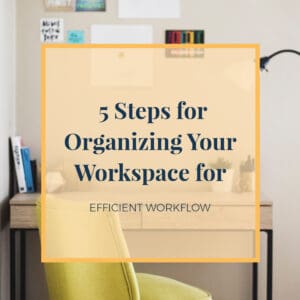5 Steps for Organizing Your Workspace for Efficient Workflow
 Regardless of whether you’re running a small business from home, working in shared office space, or still sitting in a cubicle at a large company, having an organized work space is beneficial for both your mood and your productivity. Creating a focused, inspiring, energizing work space is important if you want to be industrious during the work day and have efficient workflow. A messy, disorganized, distracting work space will draw your attention away from the important tasks at hand, make you more prone to procrastinate, and cause low-level anxiety which is counterproductive to accomplishing your goals each day.
Regardless of whether you’re running a small business from home, working in shared office space, or still sitting in a cubicle at a large company, having an organized work space is beneficial for both your mood and your productivity. Creating a focused, inspiring, energizing work space is important if you want to be industrious during the work day and have efficient workflow. A messy, disorganized, distracting work space will draw your attention away from the important tasks at hand, make you more prone to procrastinate, and cause low-level anxiety which is counterproductive to accomplishing your goals each day.
[Tweet “Workplace organization goes beyond de-cluttering: creating an inspiring environment is key.”]
No matter what amount of space you work in, you need to take steps to organize it. The same principles apply whether you have a single desk or an entire home office to yourself. The following steps are a great way to set your space up for creative thinking, efficient working, and peace of mind.
- Commit an actual block of time to getting organized
Trying to organize your desk or other work areas in dribs and drabs whenever you have a spare moment doesn’t really make a dent in the overall clutter or fix a poor set up. That stack of files you got through last week is just going to end up messy again this week if you haven’t taken the time to properly structure your organization systems. The best thing you can do, and the most time effective in the long run, is to set aside a morning or afternoon where you can dedicate yourself to a focused overhaul of your entire work space. This allows you to make real changes to the layout of your desk, files, etc.
- Clean off surfaces and clear out drawers
You need to be able to see the space you have available to use at your desk or in your office in order to make the most efficient use of it. Grab some boxes or bins to temporarily hold the contents of your work space while you figure out how best to put things back so they stay organized. While you have an empty work space, you could also take a few moments to dust or clean any surfaces and remove bits of debris that have collected in corners and drawers. Start with a truly fresh slate!
- Sort your items and cull those which are no longer useful
Every desk and office accumulates endless paper and odds and ends over the years, so you’re going to need to figure out what can go. Set up three bins (or multiples of threes, for files versus supplies, etc.) with the labels “KEEP”, “ARCHIVE”, and “TOSS”. Determine where to place each item in your workspace — what are you using on a regular basis or referring to often enough to keep it in your immediate work space, what may be important to keep for records or future reference, and what can you safely get rid of? Try not to be overly sentimental about the things which need to go; are you really ever going to need that conference booklet from years ago which you haven’t opened since? Anything in the “archive” bin should be filed away in an organized storage system so you can easily find it later if you need it. Whatever you choose to store these items in should be removed from your desk area and placed somewhere out of the way.
[Tweet “An organized office not only helps you be more productive, it’s a sign of professionalism!”]
- Set up your new organization systems
There are dozens of systems for filing and sorting work tools — read up on a few and pick one which makes intuitive sense to you. Get new organization tools if you need to: dividers for filing cabinets, in/out boxes, mail sorting bins, small drawer dividers, desktop shelves or racks for holding important publications. Hang a cork board or white board (or a 2-in-1 option!) above your desk, and maybe a calendar as well. The important thing is to set up systems which you are comfortable using. There’s no point trying to adopt some complicated, trendy system of organization if it doesn’t work for what you do, or is too difficult to remember. Keep it simple if that’s what works for you and your business.
- Repeat!
Once you’re on track and keeping an organized workspace, it’s always a good idea to set aside some each day to clear it up. As I work each day, I toss old papers into the recycling bin, archive items which are no longer being used, file paperwork and put back supplies as soon as I am done using them. I also get rid of random stuff that has accumulated, or add a new system for organizing something which is still messy after the first round. Practice makes perfect, and eventually you’ll have a truly functional work space tailored to your individual habits and needs while at work. I promise you will see a rise in your productivity, your anxiety levels will go down and you will find yourself more inspired to create great work!

Having a clean and clear workspace only helps and benefits the workflow process. Grab my free download Work Space Spring Cleaning workbook and check out my spring cleaning process! I hope it will help with yours!

























[…] an organized place from which to do your work can boost your productivity, but what about your creativity? For entrepreneurs, having inspiration and creative ideas to apply […]